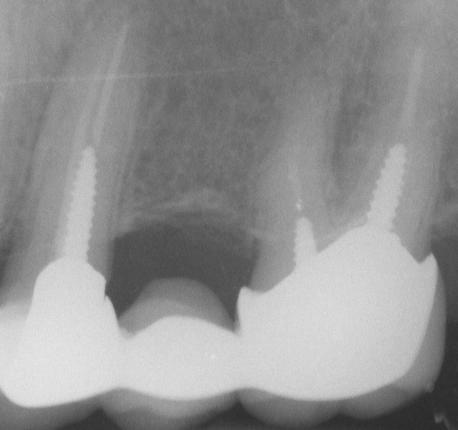
A post and core crown is a type of a restoration required where there is an inadequate amount of healthy tooth structure remaining to retain a conventional crown. A post looks like a small pin made of either stainless steel or tooth coloured material. It is cemented into a prepared space inside the canal of the root, which supports a bulk filling or restoration, which in turn gives support to the final crown.
The role of the post is firstly to retain a core restoration and crown, and secondly to redistribute stresses down onto the root, thereby reducing the risk of tooth fracture.
In post and core fabrication, it is important that the post covers at least two third of the length of root canal (or not less than the height of the crown) in order to provide sufficient support. Width of post should be taken into account for maximum strength and resistance to fracture, however, it should not be too broad as this would lead to lateral perforation and root fracture.
THERE ARE DIFFERENT TYPES OF POSTS
Prefabricated PostPrefabricated post and cores take less time to place, as they do not involve any lab work and can be inserted immediately upon the decision to utilize them, once the root canal treatment is completed. After the prefabricated post is properly cemented into the post space, a core material, such as dental composite, can be packed around the cemented post. After the material has been cured or has had a chance to set and properly formed into a crown preparation, an impression can be taken for the fabrication of a prosthetic crown.
Cast PostIn cases where the post space is not a good match for a prefabricated post, a cast post and core can be custom fabricated for the tooth. An impression of the post space is made using suitable materials which is then used for fabricating the core structure of the tooth.
Materials used for posts
Posts can be made from non-metallic materials and metals.
Non-MetallicOverall, non-metallic posts show a lower incidence of root fracture due to their ability to resist high stress without permanent deformation and breaking. Non-metallic posts should not be used if there is insufficient sound tooth tissue(ferrule). The sound tooth tissue should be at least 1.5mm circumferentially further apical to the core. Non-metallic posts are also more aesthetic than metal posts as metal posts will shine through all-ceraminc restorations.
ZirconiaZirconia posts have high strength. However, they are brittle and have a high modulus which can potentially lead to root fracture. It can be difficult to remove the posts if needed. Zirconium posts can't be etched, thus leading to difficulty in retention of composite core.
CeramicCeramic posts are made from a brittle material. These posts can be too strong which can lead to root fracture. It can be difficult and even impossible to remove a ceramic post.
Fibre Reinforced ResinsFibre reinforced resins are a form of non-metallic posts and include carbon fibre, fibreglass and woven polyethylene ribbon-reinforced composites. These posts are more flexible, more aesthetic, and they have similar properties to dentine. However, they can only used when there is sufficient tooth tissue remaining as they can delaminate upon exposure to moisture and this can lead to post failure.
Carbon Fibreposts show very little deformation and are able to absorb and transfer forces similarly to dentine. However, these posts can be dark in colour which may lead to an unaesthetic result as the post can shine through the tooth.
